Rich, Beautiful, Dreamy Dirt…
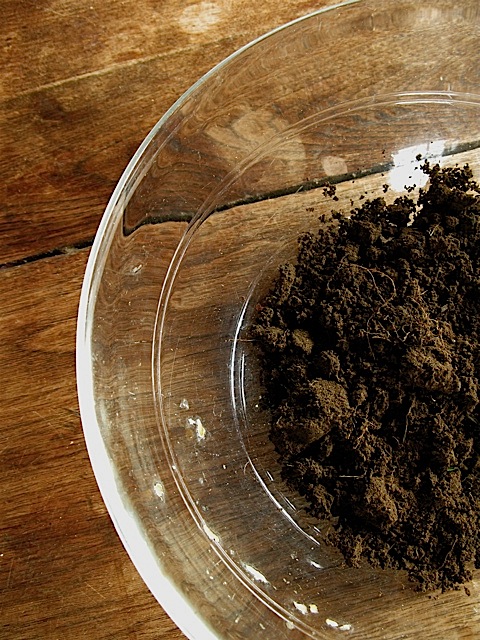 A nice delicious bowl of…. dirt?
A nice delicious bowl of…. dirt?
Has someone been making mud-pies? Sometimes I think I got into gardening because I never grew up. Yes, I know, that is a silly photo. But I couldn’t help myself. All the cooking blogs and magazines showcase gorgeous, slightly-off center bowls filled with the most mouthwatering food. So I got to thinking – what about the plants? They need to eat too! If plants could read cooking blogs, this photo would really pull them into the recipe – rich, beautiful, dreamy DIRT !
There is nothing more exciting to me than playing in a big, sun-warmed pile of dirt. I just love it. And of all the gardens I work in, it’s the vegetable plots I get really excited about – think of all those mounds and mounds of dirt! So, right now I am having a ball, because fall is when I usually plan and prep new vegetable plots. This is the best time of year to test and supplement garden soil, because it takes awhile for organic materials to decompose and for pH to change, (more on that in just a bit…). If I make adjustments now, the soil chemistry will have plenty of time to correct before next year’s planting season rolls around. So I have been playing with dirt a lot lately. Glee !
Great vegetable gardens always begin with beautiful, fertile earth. And every kitchen gardener wants a productive potager filled with healthy plants and colorful, plump, delicious vegetables. The good news is that building productive soil isn’t magic – it’s simple science. But in order to give plants what they need, a gardener needs to observe soil structure and learn a bit about chemistry…
I am going to keep this as simple as possible, because most of us aren’t aiming to turn our backyards into farm-schools – we just want our little plots to produce good food! It really only takes a half an hour, a few supplies, and a little effort to get the basic answers you need about your soil’s fertility and, if need be, how to correct it.
Plants require Nitrogen (N), Phosphorus, (P) and Potassium, (K) in order to steadily grow a strong framework and create vigorous, richly colored leaves. Plants with insufficient nitrogen often look yellowish and unhealthy, and if a garden is low in phosphorus, plants will be stunted and produce poorly, (a purplish cast on tomatoes is a common sign of phosphorus deficiency). Potassium deficiency is harder to detect, but equally problematic. Plants suffering from potassium deficiency are internally weak; unable to control moisture and distribute nutrients, among other things. And perhaps most important of all, in order for a plant to absorb N, P and K, the soil needs to have the correct pH level. Nutrients will not dissolve in water that is too acid or too alkaline, and unless nutrients dissolve in water, plants can not absorb them through their roots. No one wants to starve their garden! How can a garden feed us, unless we feed it ?
A simple and fun way to find out about your garden’s soil chemistry is to buy a home soil-testing kit. This is a great project to do with kids. Basic soil chemistry kits are inexpensive, (almost always under ten dollars for a basic kit, and under 20 for more extensive testing), and can be purchased in most garden centers and mail-order supply stores online. The kit I use most frequently requires a one to five ratio of dirt to water for testing nutrients. So I begin by scooping up a cup of soil from the garden, or if I am working in a large garden and want to do various tests, I will take a cup from several different areas, (marking the sample with a location note)…
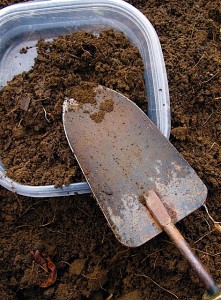 Soil sample scooped from the vegetable garden. Take your sample 4-5 inches below the surface for best results…
Soil sample scooped from the vegetable garden. Take your sample 4-5 inches below the surface for best results…
I usually test soil pH first, since I only need a small amount of dry soil, (see photo below). This particular soil-testing kit requires that I add soil to the first line of the test-tube. I then add pH reactive powder, (it’s non-toxic and safe for kids to handle), from the color-coded kit, add water to the top line, replace the cap and shake the vial, (ideally distilled water, which you can get in most supermarkets, should be used for all of these tests). This test-tube is set aside while I continue with the rest of my experiments…
Next, I take my cup of garden soil and place it in a glass, ceramic or plastic bowl. To the dirt, I add five cups of water and stir thoroughly. This muddy mixture needs to settle for at least ten minutes. So, while I am waiting, I investigate the results of my pH testing…
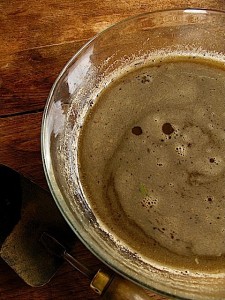 Next, five cups of water are added to one cup of soil, stirred and left to settle 10 minutes or so…
Next, five cups of water are added to one cup of soil, stirred and left to settle 10 minutes or so…
Below you will see pH test-results from two different vegetable gardens. The color of the water will range from dark green to bright orange, with green indicating alkalinity and orange, acidity. It sometimes helps to put a piece of white paper in back of the tube when comparing the color-results with the pH chart. The first test, (A: directly below), indicates that the pH is just slightly more acidic than neutral. Most plants prefer a pH in this range – but it is always a good idea to know the exact preference of your crops. Soil testing kits usually come with a small pamphlet about this, but if not you can look this information up in a good gardening book, (see recommended book linked below). The third photo, (B), indicates alkaline soil. The soil in this garden will need to be amended in order for plants to properly absorb nutrients…
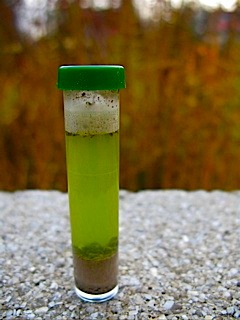 Test B: Here is an alkaline soil sample, (it actually looked darker greener than it appears in this photo). This soil will need to be amended with organic matter and/or agricultural sulfur this fall in order to bring it closer to the acid-neutral range.
Test B: Here is an alkaline soil sample, (it actually looked darker greener than it appears in this photo). This soil will need to be amended with organic matter and/or agricultural sulfur this fall in order to bring it closer to the acid-neutral range.
Soil that is too acidic for vegetable gardening can be corrected, (or ‘sweetened’ as farmers sometimes say), with lime. Limestone and wood ash both raise pH. Organic lime can be purchased at most garden/home centers. Be sure to follow instructions and wear a mask when spreading lime on soil. Wood ash is an old-fashioned remedy for poor soil, and it is useful because ash also adds magnesium and potassium. If nutrient testing reveals low potassium, then wood ash is a good, economical supplement for an acidic vegetable garden. However, if the garden soil is alkaline, (as in test B), wood ash should not be added.
If test results reveal alkaline soil, (as in vial B, above), there are two ways to lower the pH. The best long-term solution for improving alkaline soil is to add organic matter. Composted oak leaves, pine needles, peat moss or untreated sawdust are all good supplements. However, it takes time for these additives to work. So, if you are looking for faster results, or your soil is very alkaline, (like test B, above), then adding agricultural grade sulfur makes sense. This supplement can be purchased at garden centers and it is applied in the same manner as lime. Always work additives into the soil with a garden fork after they have been applied, and then cover the bed with a good, thick layer of compost.
For the next three tests, (N,P,K), samples are drawn from the bowl containing the soil-water mix. Take care not to disturb the settled soil when obtaining the samples. There is a bit of organic matter floating in the tubes shown below. A small amount is OK, (it can be tricky to get a clean catch in super organic soil, especially for little hands), but try to keep as much as possible out. Your results won’t be skewed from a bit of floating debris, so no worries if some gets in the tube. Next add the reactive powder to each vial, replacing the color-coded cap to match the test. Be sure your caps are on tight! Then, shake the tubes and wait another 5 to 10 minutes for color-results…
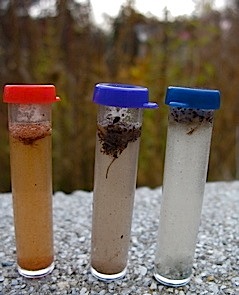 Here are some test results for K, N and P Â – The Potash, (orange) content is good. Nitrogen, (purple) is very low, and the Phosphorus is depleted, in fact it’s just about non-existent !
Here are some test results for K, N and P Â – The Potash, (orange) content is good. Nitrogen, (purple) is very low, and the Phosphorus is depleted, in fact it’s just about non-existent !
When the color in the tubes has developed, match your results with the chart provided in the testing kit. Low and depleted levels of nutrients can be corrected with organic supplements. Low nitrogen? Good compost will raise the nitrogen in garden soil and fish emulsion or blood meal will also correct low nitrogen. During the growing season, cover crops like alfalfa can also be turned into the soil to raise nitrogen levels. How you improve soil fertility depends upon when you are correcting the situation and how depleted the soil is. In cold climates, adding a rich layer of compost to the soil in fall will often do the trick for correcting fertility in the long term. But if levels are particularly depleted, additional supplements may be needed. The phosphorus test above indicates complete depletion. To improve this situation, rock phosphate is recommended. Like the other supplements mentioned, this can be purchased at any garden center. Always follow instructions on the bag. The orange-capped test above indicates ample potassium. If potassium is low however, it can be improved by adding granite-dust, greensand or wood ashes. But remember, wood ashes will raise pH. Only add wood ashes if your pH test indicates acidic soil. And remember, you can add supplements like greensand and rock phosphate to your compost as well – they are all natural…
In addition to checking soil chemistry, it is important to have a look at soil structure. If a garden has particularly sandy soil, or clay soil with poor drainage, now is a good time to add organic matter to the garden. Compost, leaf-mold, clean straw and other organic matter can be worked in and raked over the garden in the autumn. This healthy mix of ingredients will continue to decompose over the winter months, building a healthy, hearty stew for next year’s plants.
Building a vegetable garden, testing and building soil can be fun and rewarding for kids. This soil testing process is a great way to teach young gardeners about practical science. For less than $20, a real-life skill can be acquired while having a great time. For more information about creating great vegetable gardens, I highly recommend Edward C. Smith’s book, The Vegetable Gardener’s Bible , linked below. This book is easy to read and follow, and it makes a great gift for beginning vegetable gardeners, (and even the more experienced, for reference!)…
***
Article and photographs copyright 2009, Michaela at The Gardener’s Eden
All content on this site, (with noted exceptions), is the property of The Gardener’s Eden and may not be used or reproduced without express written permission. Inspired by something you see here? It’s a small world and link-love makes for fond friendships. Stealing makes for bad dreams…
7 Replies to “Rich, Beautiful, Dreamy Dirt…”
Comments are closed.
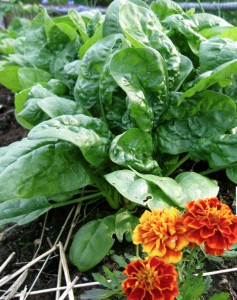
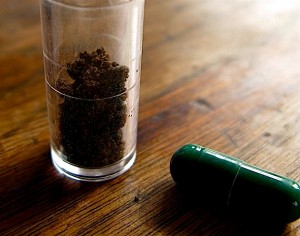
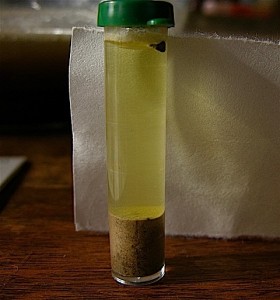
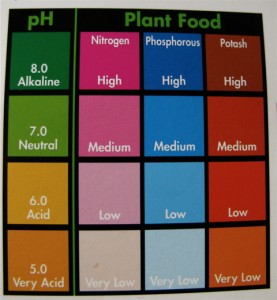

Greetings from the Pacific Northwest –
Just had to tell you, this was a GREAT blog post! and you have inspired me (at last) to actually DO a soil test instead of sitting around wondering how good my soil actually is!! I appreciate how clearly & simply you laid out the directions for doing this – it ain’t rocket science is it, especially with a simple test kit.
On that note, I was wondering if you are comfortable sharing the name/brand of test kit you used for your test? Feel free to email me at the address I’ve posted above.
Thanks again!
C. Carter
Hi there,
Thank you so much for visiting, and for the great feed-back. Soil testing is indeed very quick and simple – but it does have some kind of false ‘mystique’ doesn’t it?
I use rapitest most of the time. If you have a large garden or areas with differing soil conditions, I would get the larger kit. It is under 20 bucks and you can use it for several sections or test in fall and again in spring, (a good idea). I have posted an Amazon link for a kit here, and will post this link on my site too… but I am fighting a bit with code today. You can order it online or find it in a garden center:
Soil Test Kit -40 Tests Nitrogen/Phosphorus/Potasium/pH
Hi there,
Super post, Need to mark it on Digg
Thank you
Ivan
Ooh There are many excellent posts here on your blog.